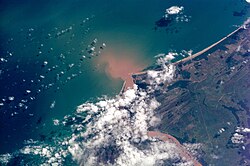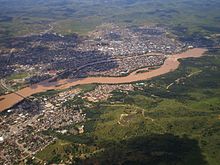geo.wikisort.org - River
The Doce River (literally the "sweet river"; Portuguese: Rio Doce [ˈʁiu ˈdos(i)]) is a river in southeast Brazil with a length of 853 kilometres (530 mi). The river basin is economically important. In 2015 the collapse of a dam released highly contaminated water from mining into the river, causing an ecological disaster.
This article needs additional citations for verification. (February 2013) |
| Doce River | |
|---|---|
 Doce River delta at the Atlantic Ocean. | |
| Native name | Rio Doce (Portuguese) |
| Location | |
| Country | Brazil |
| Physical characteristics | |
| Mouth | |
• coordinates | 19.6558°S 39.8148°W |
Course
The Doce River is formed by the junction of the Piranga and the Carmo[1] near the historical city of Ouro Preto, whose sources are located in the foothills of the Mantiqueira and Espinhaço mountain chains at altitudes of about 1,200 m. It flows in a northeastern direction via Ipatinga, makes a wide curve near Governador Valadares, and flows in a southeastern direction passing through Conselheiro Pena, to enter the Atlantic Ocean near Linhares in Espírito Santo state. Its main tributaries are the Piracicaba, Casca, Matipó, Caratinga-Cuieté, Manhuaçu, Santo Antônio and Suaçuí Grande, in Minas Gerais; the Pancas, Guandu, and São José, in Espírito Santo.

Part of the river basin is contained in the 3,562 hectares (8,800 acres) Augusto Ruschi Biological Reserve, a fully protected area.[2] South of the point where the Piracicaba enters the river near Ipatinga the river forms the eastern boundary of the Rio Doce State Park.[3]
Economic value
The Doce river has great economic importance for the region. The basin is home to the largest steel making complex in Latin America. Three of the five largest companies in Minas Gerais state in the year 2000, Companhia Siderúrgica Belgo Mineira, Arcelor Mittal (Acesita) and Usiminas, are located there. The largest open-pit mine in the world is operated in the basin by the Companhia Vale do Rio Doce. These industrial conglomerates have an important role in Brazilian exports of iron ore, steel, and cellulose (Cenibra). In addition, the Doce basin contributes greatly to production of coffee from Minas Gerais and Espírito Santo as well as fruit pulp from Espírito Santo.
Fifteen percent of the GDP of the state of Minas Gerais is produced in the region with the municipality of Ipatinga accounting for 5.4% of that total. Ipatinga is the major city of the Vale do Aço Metropolitan Area.
The economy of the basin is based on the following activities:
- agriculture: dairy and beef cattle, pig raising, coffee, sugar cane, fruits and vegetables and cocoa;
- industry: siderurgy, metallurgy, mechanical, chemical, food, alcohol, textile, leather, paper and paper pulp; and
- mining: iron, gold, bauxite, manganese, and precious stones.
According to the Anuário Estatístico do Brasil (IBGE) the Doce basin has a population of about 3,100,000, with the urban population making up 68.7% of the total population. In recent years the population has declined, with small towns and rural areas losing up to 40% of their population.
Major cities located along the Doce or in its basin are: Timóteo, Coronel Fabriciano, Ipatinga, Governador Valadares, Colatina, and Linhares.

Climate
According to the Koppen classification, there are three climatic types in the Doce basin:
- Tropical with altitude climate with summer rains and cool summers, present on the slopes of the Mantiqueira and the Espinhaço Mountains and at the sources of the Doce river.
- Tropical with altitude climate with summer rains and hot summers, present at the sources of its tributaries.
- Hot climate with summer rains, present in the middle and lower sections of the Doce and its tributaries.
Environmental disaster
On 5 November 2015, a mine dam holding back waste water from an iron ore mine in Mariana, South-Eastern Brazil, owned by Samarco, a joint venture between Vale and BHP Billiton, collapsed, devastating a nearby town with mudslides, killing at least 17 people, injuring more than 50 and causing an enormous ecological damage,[4] and threatening life along the Rio Doce and the Atlantic sea near the mouth of the Rio Doce.[5] About 60 million cubic meters of iron waste flowed into the Doce River. Toxic brown mudflows reached the Atlantic Ocean 17 days later.

References
- "Doce River". Encyclopædia Britannica. Retrieved 19 January 2013.
- Unidade de Conservação: Reserva Biológica Augusto Ruschi (in Portuguese), MMA: Ministério do Meio Ambiente, retrieved 19 April 2016
- Marques, Chris, Conheça o Parque Estadual do Rio Doce (in Portuguese), retrieved 6 February 2017
- " in Financial Times, 13 November 2015
- "Anger rises as Brazilian mine disaster threatens river and sea with toxic mud". 22 November 2015. Retrieved 23 November 2015.
External links
- Map of Doce and Jequitinhonha Rivers Copied from Documents Found in the House of Representatives from the 19th century. (in English and Portuguese)
На других языках
[de] Rio Doce
Der Rio Doce .mw-parser-output .IPA a{text-decoration:none}[ˌχiu ˈdosi] (wörtlich „Süßer Fluss“) ist ein Fluss, der im Südosten Brasiliens in den Atlantik mündet. Von der Quelle in der Serra do Espinhaço im Bundesstaat Minas Gerais bis zur Mündung 100 km nördlich von Vitória im Bundesstaat Espírito Santo misst er 853 km. Vor der Mündung liegt eine Sandbank.- [en] Doce River
[es] Río Doce
El río Doce es un río en el sureste de Brasil que desagua en el océano Atlántico. Los drenajes de los estados de Espírito Santo y Minas Gerais, la cuenca más importante plenamente incluidas en el sureste. Sus principales afluentes son los ríos Xopotó, Piracicaba, Casca, Santo Antônio, Manhuaçu y Guandú.[it] Rio Doce
Il Rio Doce (in portoghese "Rio Doce", letteralmente "fiume Dolce") è un fiume brasiliano, noto per la catastrofe ambientale provocata dal crollo di un bacino di lagunaggio avvenuta a Mariana nel novembre del 2015.[ru] Риу-Доси
Ри́у-До́си[1] (порт. Rio Doce) — река в Южной Америке.Другой контент может иметь иную лицензию. Перед использованием материалов сайта WikiSort.org внимательно изучите правила лицензирования конкретных элементов наполнения сайта.
WikiSort.org - проект по пересортировке и дополнению контента Википедии
